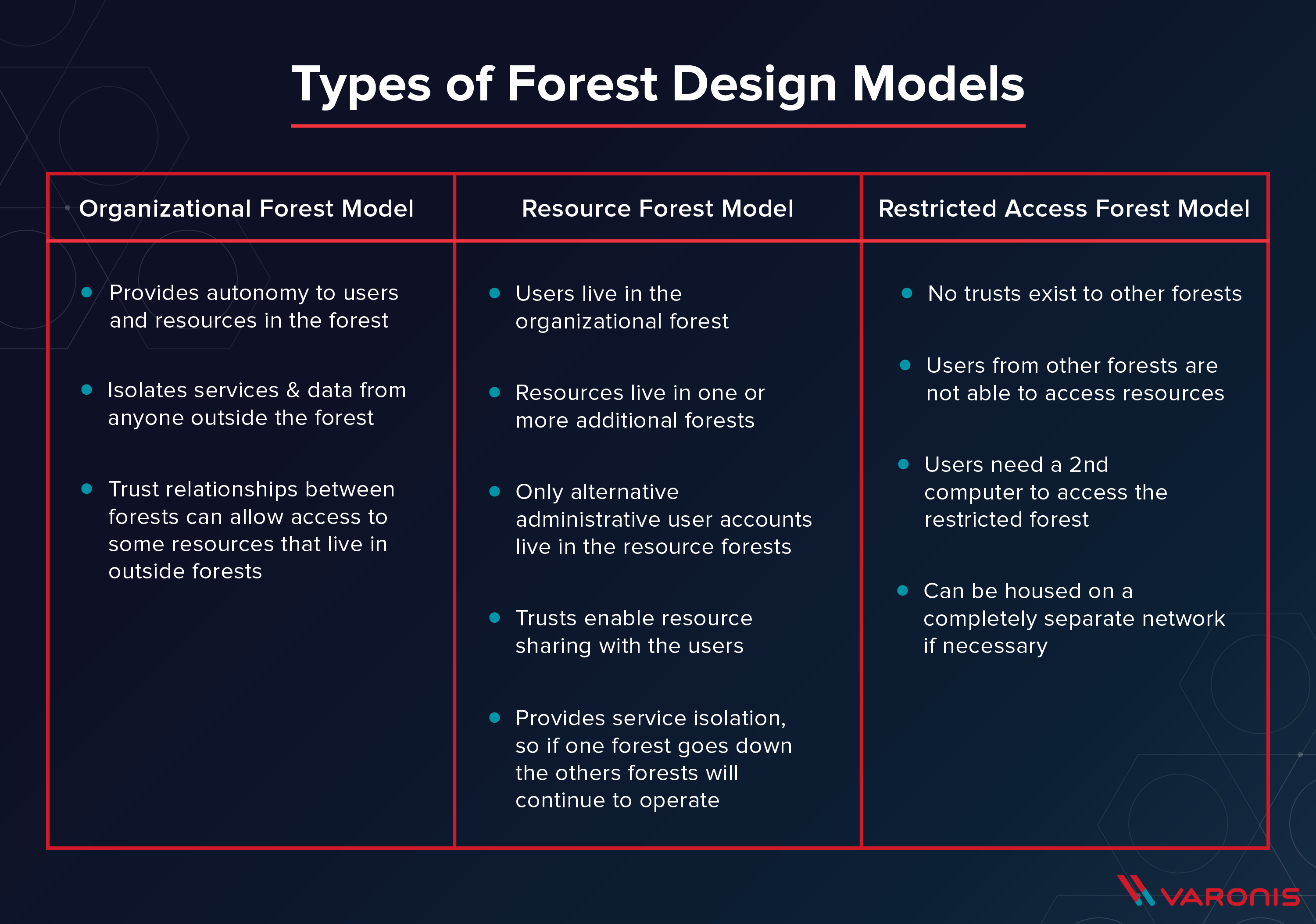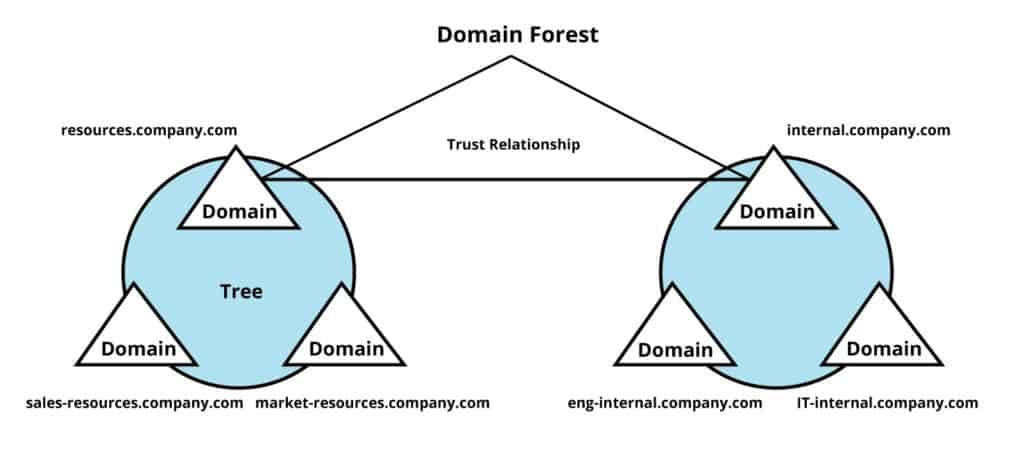Name and Explain the Different Ad Ds Trust Types
This is why they are. Both are living trusts which means theyre established during your lifetime.

What Is An Active Directory Forest
For example the GC would store the distinguished names first names and last names of all usersallowing someone to search for anyone named Tony.

. Figure 37 You can select the trust type required from the Trust Type page. Shortcut Trust will make a trust path shorter between two domains in the same forest. Parent-child trust is automatically generated when a child domain is added to a parent domain.
The trustee cannot be compelled to make distributions to a beneficiary or to the beneficiarys creditors. The Shortcut Trust can be one-way. Trusts are generally classified as either revocable or irrevocable.
Because both trusts are. Two-way Creates a two-way trust. There are Five types of Trust in Active Directory Parent-child Trust.
In Windows Server 2003 there are two types of truststransitive trusts and nontransitive trusts. A QTIP trust is a testamentary trust under which estate assets are transferred to a trust to provide for the support of a surviving spouse during the surviving spouses life after which the assets are distributed according to the terms of the trust instrument as designated by the first spouse. An AB trust also known as a Credit Shelter Trust or Bypass Trust allows wealthy couples to avoid estate taxes while passing on their assets.
For example domain D directly trusts domain E which directly trusts domain F. There are 4 valid values for the trustType attribute. A parent-child trust is automatically established when a child domain is added to a parent domain.
But even beyond those there are dozens of kinds of trust funds. When a new child domain is. The two default trust types are parent-child trusts and tree-root trusts.
When a new child domain is created AD applies a parent-child trust. With these two bases for categorizing trusts there are five trust types in AD which are as follows. Revocable trusts also referred to as revocable living trusts allow you to maintain control of your assets during your lifetime.
QTIPs are common among spouses who are in second marriages and have. Establishmentan express trust where the settlor establishes or creates the trust or one that is imposed by law sub-types include statutory trust resulting or implied trust and constructive trust For clarity and continuity reasons well only discuss express trusts. Each different kind has its.
The five main types of trusts are living testamentary revocable irrevocable and funded or unfunded. Depending on when it becomes effective its either a Living Trust or a Testamentary Trust. It contains the names of all objects in the AD DS server regardless of how the server has been partitioned.
A transitive trust is one in which the trust relationship that is extended to one domain is automatically extended to all other domains that trust that domain. Parent-Child Trust A transitive two-way parent-child trust relationship automatically created and establishes a relationship between a parent domain and a child domain whenever a new child domain is created using the AD DS installation process process within a domain tree. These are often created within Wills and the person.
A parent-child trust is a two-way transitive trust. The trust can be transitive and nontransitive and the trust direction can be one-way or two-way. You can change or dissolve a revocable trust if necessary.
Active Directory automatically creates two types of two-way transitive trusts when new objects are joined to a domain. There are 13 well cover today. The trust is structured so that upon the death of a wealthy individual assets are transferred to the beneficiaries named in the trustusually their childrenwhile allowing the decedents spouse to maintain rights to the.
This data store also known as the directory contains information about Active Directory objects. When a Trust is created and then immediately become effective. The Direction of Trust page shown in Figure 38 offers you a choice of the following three types of trusts.
Revocable vs Irrevocable Trusts Living Trusts Joint Trusts Testamentary Trusts Charitable Trusts Special Needs Trusts Asset Protection Trusts AB Trusts. Before diving into specific types of trusts it helps to understand the two broad categories of trusts. Revocable vs irrevocable trustsdiffer in the amou.
When a Trust is created and then does not become effective until after your death. However not all Trusts immediately go into effect. These objects typically include shared resources such as servers volumes printers and the network user and computer accounts.
It is a two-way transitive trust. Shortcut Trust is an explicitly created transitive trust between two domains in a forest to improve user logon times. For more information about the Active Directory data store see Directory data store.
Incoming Creates a one-way trust in which. The GC also contains a handful of searchable attributes for each object. Parent-child trust is implicitly established.
With that out of the way lets get started on a partial list of common types of trusts you might encounter or create. This type of trust allows users in both domains to be authenticated in each others domain. An external trust is always nontransitive and it can be a one-way or two-way trust.
Realm trusts are always created between the Active Directory forest and a non-Windows Kerberos directory such as eDirectory Unix Directory etc. The GC is an index stored on AD DS servers. When new child domains are added the.
Grantor - The Trust creator also known as Settlor or Trustor Trustee Beneficiary Now well look in detail at each of the major types of Trusts you can choose from. This trust is protected against the creditors of a beneficiary. Tree-root Trust is an implicitly established two-way transitive trust when you add a new tree root domain to a forest.

Domain Trees Forests Active Directory

Active Directory Forest What Is Ad Forest Ip With Ease

Create An Ad Ds Resource Forest Azure Reference Architectures Microsoft Docs

Active Directory A Guide To Terminology Definitions Fundamentals
Comments
Post a Comment